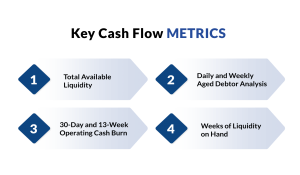
This period of protracted uncertainty has required the vast majority of large companies across the globe to redouble their focus on cash and liquidity.
Corporate treasury and finance teams will have quickly adapted their cash reporting processes to reflect the urgency of this unlikely situation. As such, many of them will now be providing senior management with daily reports on key cash flow metrics.
Indeed, this practice is almost certain to outlive the economic upheaval precipitated by the outbreak of COVID-19. Cash flow reporting, as part of a larger liquidity risk management governance framework, is likely to remain under the microscope for the foreseeable future.
At CashAnalytics, we’ve recently assisted several of our global clients in adding greater depth and granularity to their daily and weekly cash reporting so they can consistently monitor critical indicators, such as company-wide liquidity, with the requisite visibility.
This level of enhanced granularity also allows businesses to perform pivotal actual versus forecast analysis because all cash and liquidity metrics should be monitored on both an actual and forecast basis. If a metric is important today, it will be important in the future.
And while no two large companies are identical, there are certain cash flow and liquidity metrics that simply cannot be overlooked.
Metric 1: Total Available Liquidity
This is an obvious one, however, it also happens to be the ultimate bottom line. Every action now taken in a company should make the best use of available liquidity to safeguard the business in the long-term.
Liquidity is a combination of cash on hand within the business – held in bank accounts or highly liquid cash investments – and external credit facilities that can be drawn down on short notice.
In large companies, the process of calculating both current and forecast liquidity can be difficult due to the number of moving parts. It is an essential metric, though, and every effort should be made to track it very closely.
Metric 2: Daily and Weekly Aged Debtor Analysis
Most debtor analysis is carried out on a 30, 60, or 90-day basis. To effectively manage liquidity and cash in the near-term, debtors need to be analyzed and forecast to at least a weekly, if not daily, level of granularity.
The unwind of the debtor book is the primary source of cash flow into a business. During times of stress, staying close to how the debtor’s book behaves, particularly the payment patterns of key customers, will allow greater efficiency in short-term cash and liquidity management.
Moreover, it also makes mid and long-term planning easier as this behavior can be factored into future assumptions.
Metric 3: 30-Day and 13-Week Operating Cash Burn
When operating cash flow assumptions have been updated to reflect changing variables, short to medium-term operating cash burn, in the form of 30-day and 13-week analysis, needs to be diligently tracked.
Cash burn of any kind must be rigorously surveyed but analyzing cash burn versus historic trends will highlight whether the burn is merely seasonal or if a new trend is emerging.
Metric 4: Weeks of Liquidity on Hand
This is a measure of the availability of relative liquidity. It shows how long the cash or liquidity on hand can support the business through a period of stress or excessive cash burn.
The weeks of liquidity on hand is a key measurement of financial risk and should be continuously analyzed under different scenarios to essentially calculate the liquidity runway of the business in weeks as underlying economic and business conditions change.
The Necessity of Scenario Analysis
While the liquidity and cash flow metrics above provide key insights into the financial health of the business, it is also crucial, especially amid such volatility, to frequently interrogate them under changing assumptions and various scenarios.
CashAnalytics is a cash flow forecasting software that allows medium to large-cap companies to quickly capture and consolidate the data they require for meaningful cash management and reporting.




